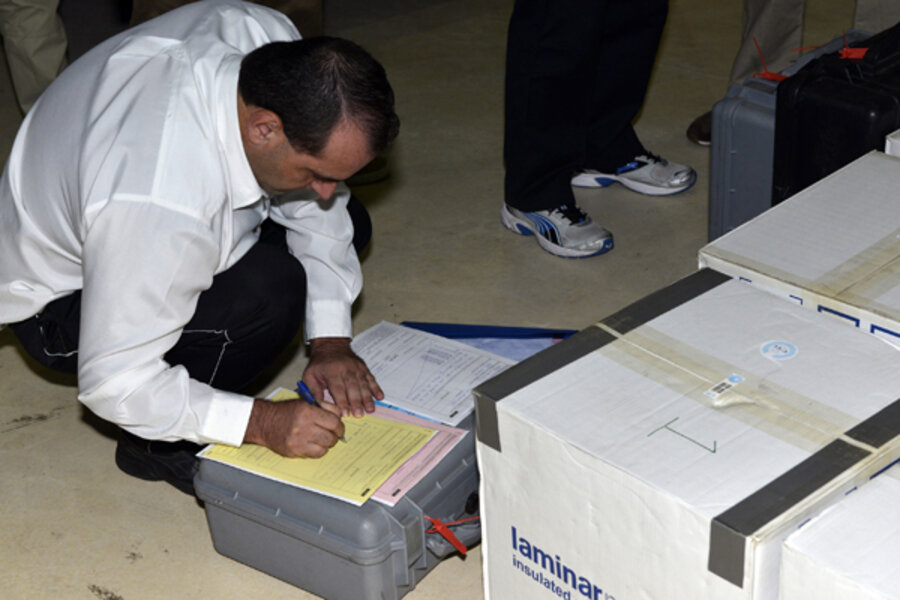Syria's chemical weapons plants destroyed – but actual weapons remain
Loading...
A daily roundup of global reports on security issues
Syria has destroyed its declared chemical weapons production and mixing facilities – meeting a crucial deadline – the Organization for the Prohibition of Chemical Weapons said Thursday.
The announcement was “depicted as a significant milestone, since it presumably means that Syria could no longer produce chemical weapons,” The New York Times reports.
The Netherlands-based OPCW, winner of the Nobel Peace prize this month, wrote in a statement that it had inspected all but two of the production sites and facilities declared by Syria this month:
“The Joint OPCW-UN mission has inspected 21 of the 23 sites declared by Syria, and 39 of the 41 facilities located at those sites. The two remaining sites were not visited due to safety and security concerns. But Syria declared those sites as abandoned and that the chemical weapons program items they contained were moved to other declared sites, which were inspected,” the statement said.
“The joint mission is now satisfied that it has verified — and seen destroyed — all of Syria’s declared critical production and mixing/filling equipment.”
Syria agreed to destroy its chemical weapons arsenal by mid-2014 after the US threatened retaliation for a nerve agent attack in a Damascus suburb on Aug. 21 that killed hundreds.
Both the government of Syrian President Bashar al-Assad and rebel forces – entrenched in a 2.5-year civil war that has left more than 100,000 dead – deny responsibility for the attack.
Ralf Trapp, an independent chemical weapons disarmament specialist, told Reuters that Thursday’s announcement was “a major milestone in the effort to eliminate Syria's chemical weapons program,” but also issued a warning. "It’s important to ensure that the remaining facilities can be inspected and their equipment and weapons inventoried and prepared for destruction as soon as possible,” he said.
Yet the OPCW now faces the more challenging task of destroying Syria’s chemical weapons stockpile – thought to include more than 1,000 tons of mustard gas, the nerve agent sarin, and other prohibited chemicals.
The international community has struggled to come to agreement on where and how the chemical weapons will be destroyed.
As The Christian Science Monitor reported earlier this week Norwegian Foreign Minister Børge Brende said that the country was forced to drop a US request to destroy the chemicals in Norway due to “time constraints” and “technical and legal restrictions.”
“We don’t have a hydrolysis facility, full capacity for burning the organic waste, nor found an area or port,” Mr. Brende told a news conference. “There is a short time frame here and the Americans have concluded that it is not possible with all these uncertainties."
The Christian Science Monitor’s Nicholas Blanford described the technical challenges of chemical weapons destruction:
Once the arsenal has been logged and secured, the OPCW will have to decide on the best means of destroying the weapons. In the past, chemical weapons were often simply tossed into the sea. In 1947, Britain and the Soviet Union disposed of an estimated 65,000 tons of German chemical weapons by dumping them into the Baltic Sea, where today the corroding containers pose a health risk to surrounding nations.
The adoption of the CWC in 1997 effectively ended such haphazard practices. Today, the favored destruction methods are incineration, hydrolyzation, and detonation with explosives.
Incineration requires the chemical agent to be drained from the weapon, such as a rocket or artillery shell, and incinerated at temperatures around 2,000 degrees F. Any explosive elements in the shell or missile, as well as the contaminated metal components, are burned in separate furnaces. The released gases are scrubbed with both wet and dry filters before the end product is released into the atmosphere.
Hydrolyzation involves the addition of hot water and caustic agents such as sodium hydroxide, which destroy the toxicity of the chemical agent. The neutralized agent can be burned in an incinerator or treated, similar to sewage water.
In explosive destruction, the chemical-bearing munitions are placed in a reactor and detonated or neutralized with chemical treatment.








